Six turning and four burning…
The Convair B-36 Peacemaker was the primary nuclear weapon strategic bomber of the USAF Strategic Air Command (SAC) from 1948 to 1959 (it started to be replaced in this role from 1955 when the Boeing B-52 Stratofortress was first introduced with all being replaced 1958-1959). The B-36 had a range of 16,000 km (10,000 miles) meaning it became the first bomber with a unrefueled intercontinental striking range – enough to fly from the east coast of the USA to Moscow and back.
In the 11 years the B-36 Peacemaker was in service it was never used in combat. It’s role as a nuclear deterrent to the Soviet Union during the Cold War could not have been better summed up than in its name.

WORLD WAR TWO ORIGINS
The B-36 design process originally began in 1941 from a requirement to have a strategic bomber that was capable of bombing targets in Europe from bases in the United States. As World War Two progressed this requirement changed to bombing targets in the Pacific theatre but with the success of the Boeing B-29 Superfortress the aircraft was more or less put on the back-burner.
Although the war was over in 1945, with the “success” of the nuclear bomb it was determined that a nuclear bomber aircraft was required and the B-36 eventually entered production in 1946 (the prototype first flew on August 8th, 1946). By then the Soviet Union and her Communist allies were the new potential target.

PRODUCTION & SPECIFICATIONS
Between 1946 to 1954 Convair (originally Consolidated Vultee) built 384 B-36’s. They became the largest mass-produced piston engined aircraft in history, with the biggest wingspan of any combat aircraft produced (Length 49.4 m / 162.1 ft, height 14.3 m / 46.9 ft and wingspan 70.1 m / 230 ft).

The B-36 was fitted with six reverse facing 3,800 hp Pratt & Whitney R-4360 Wasp Major radial piston engines that powered it to a cruising speed of 370 kmh / 230 mph. Introduced in the B-36D model onwards were an additional 4 General Electric J47 jet engines each with 5,200 lbs of thrust that were fitted in pairs under each wing. The jet engines could provide an additional speed boost taking the top speed of the B-36 up to 700 kmh / 435 mph when required.
This unique engine layout mix of piston and jet engines led to the saying “six turning and four burning” used by B-36 aircrews. The big bomber could reach an altitude of 13,300 m / 43,600 ft. (at combat weight).

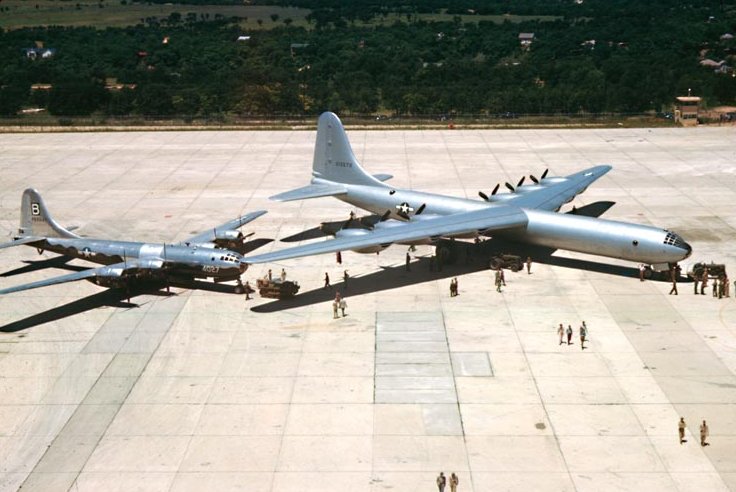

The B-36 bomber had a crew of 15 (13 in the later “Featherweight III” high altitude versions), consisting of a pilot, copilot, two navigators, bombardier, flight engineer, radio operator, radar operator, two Electronic Counter Measures (ECM) operators and five gunners. The reconnaissance version had a crew of 22 (19 in the later “Featherweight III” high altitude versions).

Armament on the bomber consisted of 16 M24 20mm cannons in eight turrets (later reconnaissance versions had just a twin 20mm gun turret in the tail) and a huge weapons payload capability of 39,000 Kg / 86,000 pounds of nuclear or conventional bombs. The B-36 could carry the massive Mark 17 Thermonuclear (Hydrogen) bomb which was 6.55m / 21.5 ft. long and weighed 21 tonnes!

PEACEMAKER VARIANTS
In addition to the B-36A/B/D/F/H/J bombers, variants of the B-36 were fitted for photo reconnaissance (RB-36B/D/E/F) and others were used for various experimental purposes including the FICON (Fighter Conveyer) project. In the RB-36D model, the number one bomb bay was equipped with 14 cameras, the second bay carried up to 80 x 100 pound photo flash bombs for nighttime photography, the third bay was for miscellaneous equipment or an extra fuel cell to extend range and the final bay was equipped with Electronic Counter Measures (ECM).
The RB-36 models differed in appearance from a standard B-36 with extra antennas and 3 extra radomes along the bottom of the fuselage (reconnaissance and ECM equipment). USAF reconnaissance missions using the RB-36 included flights from Japan over Manchuria in Communist China and the Soviet Union (flights from the UK also flew over Soviet arctic bases).


FICON
The FICON (Fighter Conveyer) project of the 1950’s involved the testing of modified parasite Republic GRF-84F Ficon reconnaissance fighters that could be launched from the bomb bay of a specially equipped GRB-36D Peacemaker RB-36 were modified for this) fitted with a retractable probe for hookup/retrieval of the fighter. The fighter could then protect the bomber from enemy interceptors or conduct reconnaissance and bombing missions over target locations (the B-36 was a flying aircraft carrier).

25 RF-84F Thunderflash were converted for this purpose in 1953 and later re-designated RF-84K. In addition to the retractable hookup equipment in the nose of the fighter, a modified anhedral tailplane was designed to better fit inside the bomber.

Testing was conducted from 1952 and between 1955 to 1956 the FICON concept saw limited operational service. Although found to be technically sound, the hookup process was extremely difficult even for experienced test pilots (yet alone in inclement weather).
The FICON project was cancelled in 1956 when the successful development of inflight refueling of fighter aircraft made it redundant to carry parasite fighters. The Lockheed U-2 high altitude reconnaissance aircraft was also just coming into service in 1956 making it even more unneccessary to carry reconnaissance fighters.
An earlier project along similar lines to FICON was the McDonnell XF-85 Goblin parasite fighter. This small jet fighter was planned to be launched from the B-36 as protection against enemy interceptors. 2 prototypes of the XF-85 were built for testing with the flying in 1948.
Although in theory the small and stubby XF-85 was a good idea it was not as fast as the enemy jets it was intended to counter and there were also issues in re-docking with the test Boeing EB-29 Superfortress (none of the then new B-36’s were available for testing at that stage). The project was cancelled in 1949.



Heavy Transport
The Convair XC-99 was a one-off prototype heavy transport aircraft developed from the B-36 that could carry up to 400 troops. It shared the same wings, engines and some other airframe components. The XC-99 was tested and used for research from 1949 to 1957 before being retired by the USAF.

Nuclear Test Aircraft (NTA) program
Scarily there was the NB-36H Peacemaker variant (originally designated XB-36H) fitted with a nuclear reactor for trials as part of the Nuclear Test Aircraft (NTA) program to test the viability of a nuclear powered bomber from July 1955 to March 1957. The NB-36H was fitted with a three megawatt, air-cooled nuclear reactor in its bomb bay (Aircraft Shield Test Reactor) and had a revised cockpit and raised nose with a special crew cabin that was lead and rubber lined.
This was the first aircraft to ever be fitted with a nuclear reactor! The crew consisted of the pilot, copilot, flight engineer and two nuclear engineers.
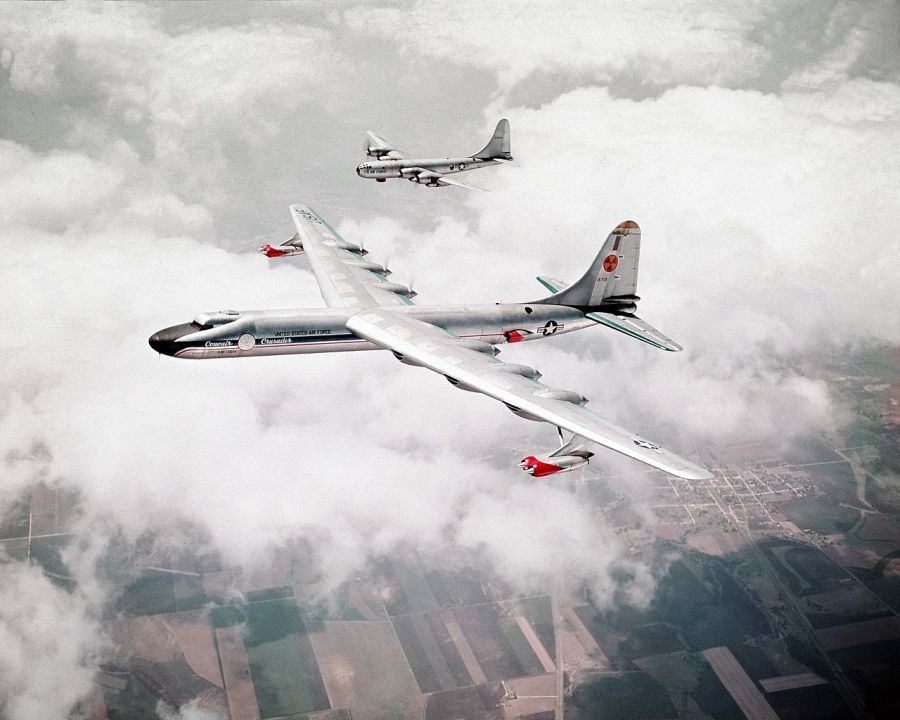
47 test flights and 215 hours of flight time were completed over New Mexico and Texas in the NB-36H (the nuclear reactor was operated for only 89 of these hours). Luckily the program was cancelled and the aircraft was scrapped in 1958.
It was bad enough having “Broken Arrow” incidents where a bomber with nuclear weapons has crashed or accidentally dropped a nuclear weapon that has not detonated yet alone having them flying around with nuclear reactors onboard! At least 32 “Broken Arrow” incidents have occurred involving US aircraft since the 1950’s, including at least one with a B-36.

Convair YB-60
A further aircraft was developed from the B-36, known as the Convair YB-60 which first flew on April 18th, 1952. The YB-60 was a larger 8 engine bomber in competition with the Boeing YB-52. It was originally designated YB-36G and was fitted with a new 37-degree swept wing, a bigger tail section and revised nose section.


The YB-60 had a top speed of 820 kmh / 510 mph and a cruising speed of 700 kmh / 435 mph. Although 330 kmh / 205 mph faster than the B-36 at cruising speed and a more efficient aircraft (the crew was reduced from 15 in the B-36 to 5 in the YB-60) the project was cancelled on August 14th, 1952 when it was obvious that the Boeing YB-52 was a faster and better option.
The YB-52 had a maximum speed 982 kmh / 610 mph with a cruising speed of 845 kmh / 525 mph). The YB-60 did have a larger bomb load, but the decision to continue with the YB-52 has been well and truly proven by the fact that the later model B-52’s are still in service today! Of the two YB-60 prototypes built only one was fully completed and unfortunately both were scrapped in the mid 1950’s (S/N 49-2676 and 49-2684 the latter was not completed).

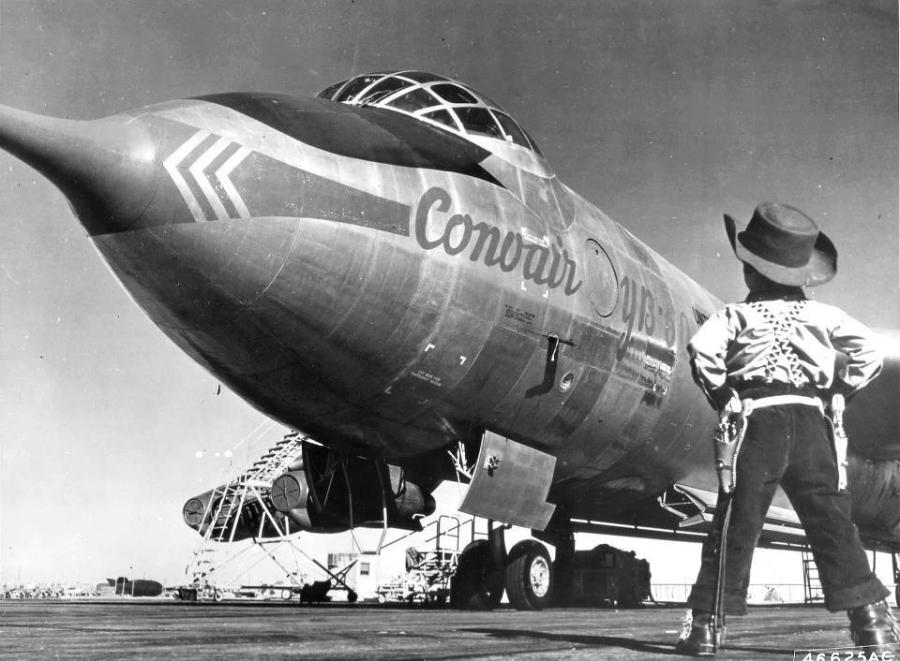

THE PEACEMAKER GOES TO HOLLYWOOD
The 1955 movie Strategic Air Command starring Jimmy Stewart as Lt. Col. Robert ‘Dutch’ Holland featured great footage of the Convair B-36 Peacemaker. In 1955 the US National Board of Review of Motion Pictures awarded the film a special citation for aerial photography and it was nominated for the Best Writing, Motion Picture Story category in the 1956 Academy Awards.
THE SURVIVORS
Of the 384 B-36’s built only 4 complete and assembled airframes exist today. All 4 are on display in museums in the United States and I am happy to say I have managed to see them all in my travels:
- B-36J (S/N 52-2220) – National Museum of the USAF in Dayton, Ohio. This is the last one to ever fly. It was flown to the museum from Davis-Monthan Air Force Base in Arizona on April 30th, 1959.
- B-36J (S/N 52-2217) – Strategic Air and Space Museum in Ashland, Nebraska. This one was built in Fort Worth, Texas and delivered to Strategic Air Command on December 22nd, 1953.
- B-36J (S/N 52-2827) – Pima Air and Space Museum in Tucson, Arizona (adjacent to Davis-Monthan Air Force Base and AMARG “the Boneyard’). This was the last B-36 built (1956) and was named “The City of Fort Worth”. In 1959 it was returned to Texas and displayed at Amon Carter Field. After years of neglect in the outdoors it was eventually taken back by the USAF and later loaned to Pima where it has been restored in the markings of the 95th Bomb Wing, Biggs AFB, El Paso, Texas.
- RB-36H (S/N 51-13730) – Castle Air Museum (at the former Castle Air Force Base) in Atwater, California. 73 RB-36H models were built and this is the only survivor. It served with the 28th Strategic Reconnaissance Wing at Ellsworth Air Force Base, South Dakota from 1952 to 1957.
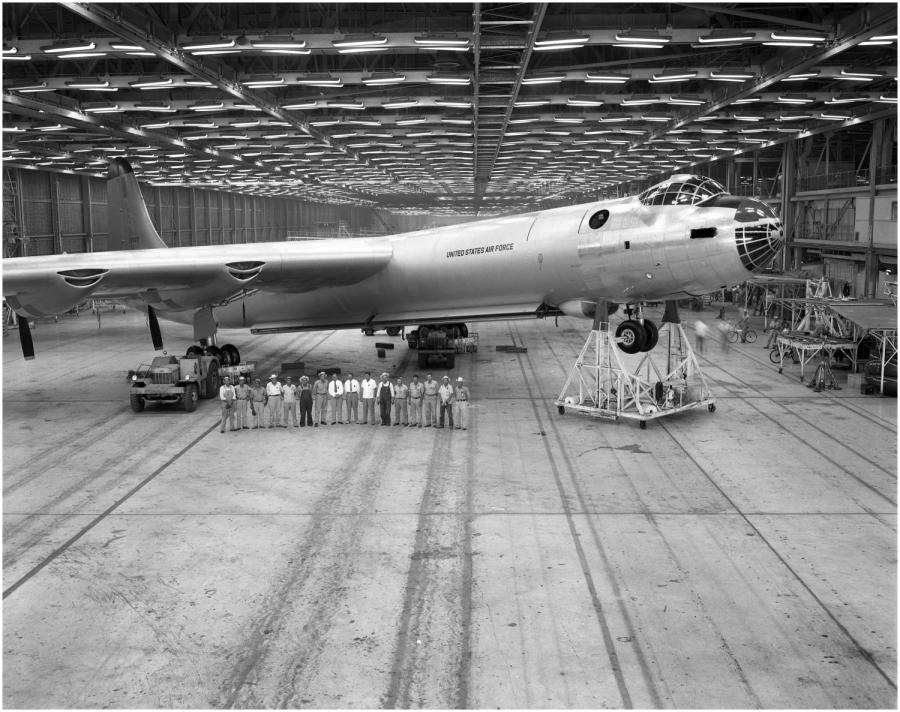
Note: There is one other disassembled example, a YB-36 (S/N 42-13571) that is in private hands in Ohio but was originally at the USAF museum. In 1972 the airframe was cut up and being readied for scrap when it was purchased and saved by Walter Soplata (it remains in pieces on his farm).
The Convair XC-99 still exists today too. It is disassembled and in storage at the USAF Museum awaiting restoration.
The B-36’s at Castle and Pima are displayed outdoors. The others are displayed indoors. The first thing you notice with the B-36 is the overwhelming scale of the aircraft. They are impressive to say the least and you cant help but feel very small when you walk around under the massive fuselage, wings and all those engines.

National Museum of the USAF
The B-36J at Dayton, Ohio was the first I ever saw. When you see that massive airframe and huge wings you cant help but be impressed. It dwarves all other aircraft around it! Unless stated otherwise the following photos were taken during my visit to the museum in 2009.




Strategic Air & Space Museum
The B-36J in Ashland, Nebraska naturally dominates the display hangar. It is interesting to see the B-36J alongside its successor the mighty B-52. Uniquely the bomber is displayed with a McDonnell XF-85 Goblin parasite fighter from the FICON (Fighter Conveyer) project. The following photos were taken during my visit to the museum in 2013.




Pima Air and Space Museum
The dry desert air of southern Arizona keeps this beautifully restored B-36J in nice shape! Pima is a massive air museum. Nearby the B-36 are three B-52’s! The following photos were taken during my visit to the museum in 2011.





Castle Air Museum
The last surviving RB-36H reconnaissance model was still undergoing some restoration when I visited the Castle Air Museum in Atwater, California in 2012 (one of the largest air museums on the west coast). The museum is opposite Castle airport which was formerly Castle Air Force Base (1941 – 1995) which in later years was the home of the 93d Bombardment Wing and the primary Boeing B-52 Stratofortress training base of the USAF Strategic Air Command. The following photos were taken during my visit to the museum in 2012.



The Convair B-36 Peacemaker is an impressive aircraft to see. Its sheer size was probably enough deterrent alone but it served its nation well in those terrifying early days of the Cold War by providing a suitable balance of power and nuclear deterrent to maintain peace when it was needed most.
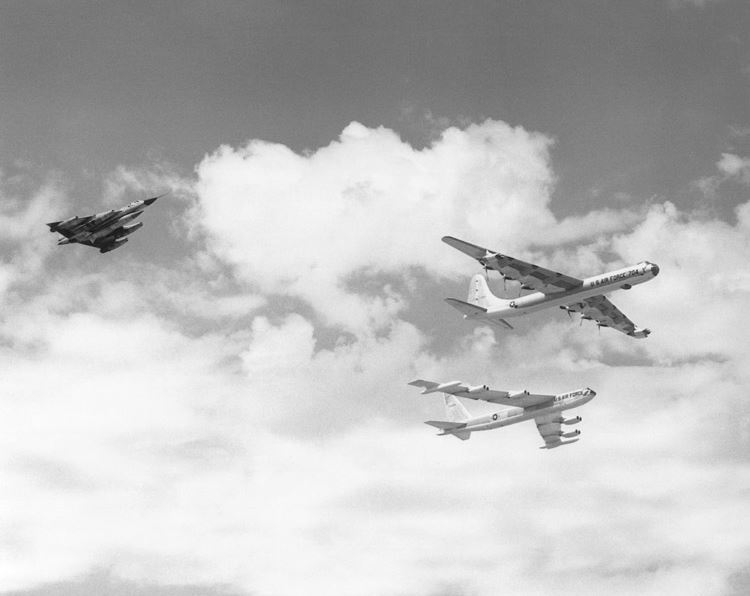

What a rich post this one is–it could be used as the source for a college level lecture, congratulations. The video clip was too cool and I think I heard “Col. Potter” as the flight engineer — I guess Harry Morgan always had that rich basso voice 😉 You have seen all the displayed Peacemakers it seems, kudos! I like how Castle Air Museum has theirs displayed now — when I saw it the Mark 17 was not there and the gun turrets were not deployed — I like the display much better how you saw it. The Peacemaker was large (it had to take off with the fuel required for the entire mission–not to mention the immensity of the Mark 17) and the last really large aircraft needed since aerial refueling began in earnest once it was built — so Peacemaker’s are the end of some sort of period. Also, two more details to add if that’s okay: 1) The construction was of magnesium alloy so crashes followed by fire left very little for the investigators, and 2) Those 20mm cannon were many and awesome but when fired their recoil vibrations shattered many of the vacuum tubes used in the radar and other electrical systems (again, the end of another era?). A marvelous post Deano 🙂
LikeLike
Thanks Joe. One of my favourite Cold War warriors. I will never forget seeing my first one at the USAF Museum – the sheer size! I wish I could have seen one fly back in the day! They were still working on the one in Castle when I was there. Long term project for sure. You are right about the guns being an end of an era, after that a tail gun was all that was deployed on bombers.
LikeLike
Here is what Pima’s B-36 looked like in 2006. https://picasaweb.google.com/lh/photo/-v8N0Fukd65jS6xPbU5FddMTjNZETYmyPJy0liipFm0?feat=directlink
LikeLike
When you look at that photo, its an amazing restoration! Thanks for sharing
LikeLiked by 1 person
Growing up in Fort Wayne, Indiana I was able to see B-36’s and B-47’s over fly the city. The story was that Fort Wayne had similar characteristics to a city in Russia. Fort Wayne was used as a practice target. It was really a thrill to see the aluminum overcast fly over. What a time to grow up.
LikeLiked by 1 person
That would have been some sight!
LikeLike
I’ve wondered how often Hoosiers got to see the B-36 in the day. Growing up in central Illinois my dad & I would go to Chanute AFB to see the RB-36 on display (currently in California). I eventually landed in Indiana. I know they made a few appearances at Detroit Air Shows so speculated where Ft. Wayne fit into a flight path. The B-36 represented an exciting time for the Air Force. Its effective career was short, though. After 1956 it was placed on the back burner. Almost an obsession, I know WAY too much about it after years of research.
LikeLike
Probably just contrails in the sky for most of them. It is an easy aircraft to get fascinated by, that’s for sure!
LikeLike
[…] My Dad was with SAC for 20 years and in the Air Force for 30 years. I’ve seen every plane that the air force had and has. Our living Quarters were right inside the main gate at Offuct air force Base so I could see planes landing and taking off. From the B-36 to the B-52, early in the mornings. I was 7 years old and have never been close to an airplane.Source: Convair B-36 – The Ultimate Peacemaker […]
LikeLike
My Dad was stationed in Omaha, at the SAC Base there OFFULT . He was with General LeMays outfit. Photo Intelligence underground there. The runway was right across the street right inside the main gate. I watched the first B-47 take off, B-36, B-52. I Built every airplane that the air force had. I joined the Navy and served 27yrs. I remember the Cuban Missile crisis my dad didn’t come home that much except to change uniforms and go back. My whole life was the Military even when I went to VietNam for 2 tours at Quang Trang, then Panama
LikeLiked by 1 person
You were inolved in a golden age of aviation. Bad times politically etc but amazing advancements in aviation. Thanks for your service
LikeLike
[…] a Falcon 9 night launch photo, and a really neat and captivating picture of the beautifully oddball Convair B-36, with contrails streaming from its six rear-facing prop engines over a dark […]
LikeLike
I lived in Dallas as a youngster in the mid 50s and B-36s were a common sight. You could tell when they were on approach to Carswell before you could seem them as the china would begin to rattle. I recall one day in particular when a flight in formation flew over my school at low altitude. Happily, it was during recess so we were all outside jumping up and down and waving frantically. The lead pilot must have seen us; he gave us a ponderous wing waggle. Made my day for sure.
There was a group restoring the City of Ft. Worth at Alliance Airport, which is north of Ft. Worth, in the 80s/90s. The story is the Air Force got wind that they intended to fly it and made them stop working on it, telling them in no uncertain terms that no B-36 would be restored to flying condition. That, I believe, is the one now at Wright Pat. Too bad, it would have been a hit at any air show with a runway big enough to handle it.
LikeLiked by 1 person
Great memories! Yes that is the same B-36. As a kid in Australia I had to settle for smaller yet much faster aircraft flying over my school (F-111’s). A formation of B-36’s must have been some sight?
LikeLike
They blotted out the sun.
I have never understood what the issue was between the guys restoring City of Ft. Worth and the AF. There is a relative plenty of B17’s and even at least 1 B-29 that are flown fairly regularly. Were they afraid they’d load it up with ordnance and go bombing? Makes no sense to me. The fact that 115/145 avgas has been made of near unobtainium for decades would pretty much preclude flying it anyway, but the AF should have kept hands off despite the fact they own it. JMHO
LikeLiked by 1 person
Imagine that fuel bill… phew. I would love to see one fly again but yeah, beyond reality now unfortunately
LikeLike
A great informative link. Please note that the pilot of 2220 for its last flight to W/P was Lt Col Karl Ross.
Now Col Ross is a retired USAF veteran, an ordained minister and a proud member and Padre of RCAF 441 (Huronia) Wing of the Royal Canadian Air Force Association. We are honoured to have him as a member of the RCAFA. http://www.rcaf441wing.com
LikeLiked by 1 person
From November 1956 to November 1960, I was stationed at Ft. Bliss, TX which was under the flight path to Biggs AFB. Many B-36 flights went right over my training areas: awesome! I loved every flight. I wrote many letters in 1990 to try to persuade the powers to fly the Chanute B-36H to Castle AFB, but to no avail. I visited the Chanute AFB and could see the runway would not allow it. When the B-36H arrived at Castle, I was privileged to be given a walk through of the area where the pieces were deposited: very sad. I have many pictures of the pieces if anyone is interested. I have since visited the assembled B-36H: nice.
LikeLike
A fantastic time in aviation – Seeing the Castle B-36 together is fantastic! Such a huge aircraft!
LikeLike
Reblogged this on War Machine Museum.
LikeLiked by 1 person
I had a relative who wired the XC-99 aircraft for interior lighting when it was in San Diego
LikeLiked by 1 person
Cool. That would have been some wiring job!
LikeLike
Amazing videos
LikeLiked by 1 person
[…] Source: Link […]
LikeLike
Very nice site. One correction though: the MK 17 was a hydrogen bomb, not an atomic bomb. Pretty big difference. 😉
LikeLike
Ha! Yeah thanks – Thermonuclear was what I intended but obviously had atomic on the brain apparently! Corrected now. Thanks
LikeLike
[…] Source: Link […]
LikeLike
[…] https://acesflyinghigh.wordpress.com/2014/08/06/convair-b-36-the-ultimate-peacemaker/ […]
LikeLike